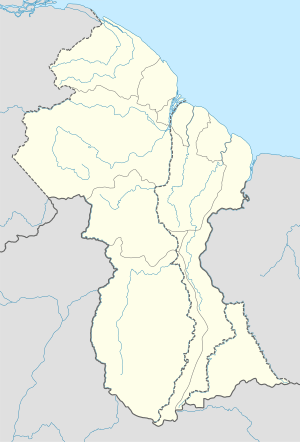Nonpareil, Guyana
Nonpareil also Non Pareil (from the French and meaning matchless, inimitable) was the name of a sugarcane plantation, and later a village, on the east coast Demerara Region of Guyana that operated until the mid 20th century. Although the factory and village were torn down and disassembled in the 1940s, its population survived and formed the majority of the population of Enterprise, a modern village located one mile away from the site of old Nonpareil.
Nonpareil Non Pareil | |
|---|---|
town | |
 Nonpareil Location in Guyana | |
| Coordinates: 6°44′N 57°56′W | |
| Country | |
| Region | Demerara-Mahaica |
| Population (2012)[1] | |
| • Total | 2,946 |
| Time zone | UTC-4 |
| Climate | Af |
History
In 1838, the first group of East Indians arrived in Guyana as indentured servants to fill the huge employment gap created on the plantations after slavery was abolished four years previously. These new workers built their first homes in the area surrounding the plantations and from the small group that lived and worked at the Nonpareil Estate arose a village whose residents called it Nonpareil.
Life in Nonpareil was poor though habitable and the community grew in time. New immigrants came and others paid their way back to India after meeting contractual obligations. By the end of the 19th century a small school and a hospital were erected, and other incentives like land ownership were offered to encourage workers to stay with the estate. The village flourished for the first few generations and life on the plantation included field work for everyone above the age of 11 at a decent wage. The children were offered a primary school education but most elected to work the fields, baling the sugarcane punts and clearing the canals.
This somewhat prosperous time did not last very long in the growing village. In fact, by 1910 living condition across the entire country were showing large signs of deterioration from lack of care and maintenance. After slavery - and the free labor that came with it - was abolished, sugar became less profitable across the West Indies and over a period of 20 years more than half of the country's factories closed, sold their machinery and their owners booked passage back to England.
By the 1940s, the handful of plantations still operating in the country were a consolidation of those that could not prosper alone. Even together, these small groups of estates still had trouble earning a substantial profit and the entire village bore the burden of economic slow down. Its people struggled to maintain their basic standards of living. This industrial down turn also brought poor wages to the already impoverished people. Before long the already degraded living conditions worsened and many villagers, especially the young, contracted diseases which in most cases took their lives - dysentery was the most widespread and the largest killer during this period.
The permeating squalid condition in Nonpareil continued throughout the 1940s and by the end of the decade daily protests in front the owner's yard were the norm. The villagers sought improvements to their poverty-stricken, slum-like surroundings but their complaints fell on deaf ears. The owners came to ignore the daily protest and elected instead to make minimal improvements which did nothing to change the poor conditions. The villagers, left without an option, resorted to their last but most effective tool: striking from the fields. Without the sugarcane from the fields the factories were unproductive, unprofitable and rendered useless. It did not take the owners very long to capitulate and striking became a useful weapon against the sometimes apathetic overseers then as it remains today against GuySuCo. In the end, the unyielding workers won larger, better drained and irrigated plots of land that were better suited to cultivating vegetation and building new homes at a new site.
The new site, which became Enterprise, was located one mile to the northeast and was not entirely unoccupied when people from Nonpareil migrated there, circa 1949. A small group of immigrants – according to most accounts 12-15 families – that were not employed by the estates had already built their first homes here. This group tended to their small farms cultivating fruits, ground provisions, plantains and vegetables. A few domesticated cattle, sheep, goats, pigs and poultry also contributed to their daily living. The villagers fished in the many surrounding canals that yielded enough to feed the entire community according to some folklores. This practice of not working on the plantations but living off the land gained popularity among the new residents and many were happy to be rid of the under-paying, labour-intensive field work. Most, however, could not afford to leave the estate as they were highly in debt to it from private and personal loans. Living off the land alone for this group could not sustain their loan payments.
Today, sugar is still the primary export of Guyana and most of the descendants of Nonpariel which makes up the population of Enterprise, are still employed by the sugar estates.
See also
- Enterprise for more information on the descendants of Nonpareil.
References
- "2012 Population by Village". Statistics Guyana. Retrieved 16 August 2020.